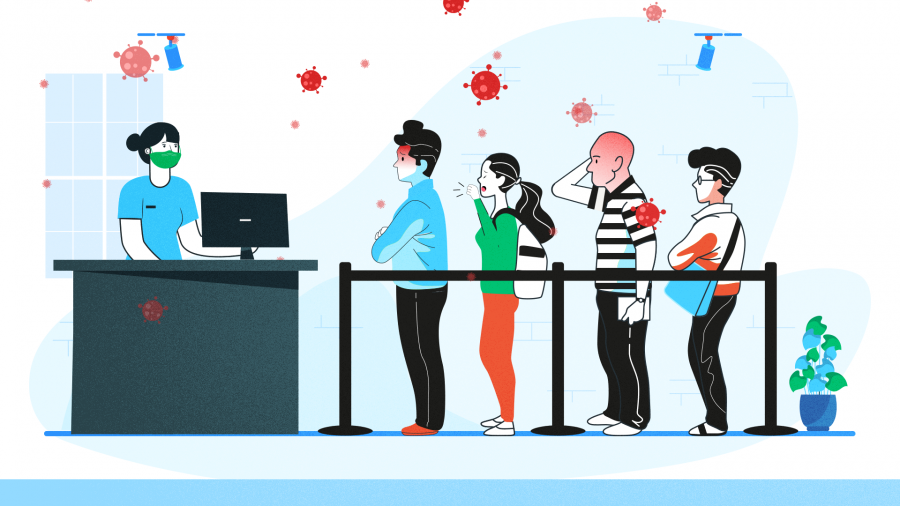The COVID-19 crisis taught us one major lesson: technology is essential for survival and adaptability in challenging times. In Tunisia and around the world, the importance of digital transformation in healthcare has been emphasized, particularly in addressing traditional queue management in hospitals, clinics, and other medical facilities. Long wait times, crowded spaces, and inefficient processes have made traditional queue management systems a bottleneck for patient flow, often leading to a poor patient journey experience.
Today, as the volume of patients continues to grow, the limitations of traditional queuing methods become more evident. Crowded waiting rooms not only create discomfort and frustration but also increase the risk of virus transmission. The need for efficient, safe, and patient-centered solutions has never been more critical. Medical professionals are now actively seeking ways to manage patient flow effectively, ensuring both the health and satisfaction of their patients.
So, as a healthcare provider, how can you improve the patient experience while ensuring their safety? Embracing technology to revolutionize queue management is the first step towards a smoother, safer, and more efficient patient journey.
Digitizing Queue Management with Liberrex’s Virtual Queue Management System
One powerful solution to modernize queue management is adopting Liberrex’s virtual queue management system. By digitizing the queuing process, patients are no longer forced to wait in crowded areas or sit in waiting rooms for extended periods. Instead, they can easily join a virtual queue with a single click from their mobile phone or computer, wherever they may be.
This virtual queue management approach offers numerous benefits over traditional queueing systems. Patients can monitor their position in real-time, receiving updates on their estimated waiting time and the number of patients ahead of them. They are also notified when their turn is approaching or if any changes occur in the queue, providing a more transparent and stress-free waiting experience. Such a system not only optimizes patient flow but also minimizes the risk of infection by significantly reducing physical gatherings in medical facilities.
By freeing patients from waiting rooms, they gain valuable time to manage other tasks. This method of online queueing can cut down the risk of virus transmission by up to 85%, save patients approximately 90% of their waiting time, and significantly enhance overall patient satisfaction. A virtual queue management system is a crucial step toward a safer, healthier healthcare environment.
Implementing an Online Booking System for Streamlined Patient Flow
An online booking system can further enhance queue management by minimizing overcrowding and wait times. With this system, patients can select a date and time that suits their schedule, allowing them to arrive just before their appointment. This proactive approach reduces unnecessary human interaction, aligns with social distancing measures, and increases your staff’s productivity by preventing overcrowded waiting areas.
Touchless Check-In for a Safer, More Efficient Queue Management Process
A self-check-in or touchless check-in system adds another layer of safety and convenience to queue management. Patients can self-register by scanning a QR code to access the virtual queue. After registration, they receive a mobile ticket to track their progress in the queue, reducing contact with shared surfaces and enhancing social distancing practices. Touchless check-in is not only a health-conscious option but also streamlines the check-in process, allowing patients to move smoothly through the queue with minimal delay.
Dear Doctor, Your Patients’ Time is Valuable
In Tunisia, long wait times in overcrowded waiting rooms, even for vaccinations, have posed a significant health risk, particularly in the context of COVID-19. Prolonged waiting periods also contribute to patient stress, which can negatively impact their well-being by weakening the immune system and making them more susceptible to infections. Efficient queue management is not just about reducing wait times—it’s about prioritizing your patients’ health and safety.
As a doctor, you have a responsibility to protect your patients’ mental and physical health. Implementing a virtual queue management system and reducing unnecessary wait times is one way to honor that responsibility. By saving your patients’ time, you not only enhance their experience but also safeguard their health.
COVID-19 Queue Management Solutions for Better Social Distancing
Virtual queue management solutions have proven to be effective in maintaining social distancing by limiting in-person interactions within healthcare facilities. By allowing patients to join a virtual queue from their homes or other locations, you can reduce the risk of virus transmission and help prevent the spread of COVID-19. In today’s healthcare environment, adopting digital queue management solutions is essential for maintaining a safe and controlled patient flow.
Viruses spread primarily through human contact. By encouraging patients to participate in online queueing, you are playing a critical role in minimizing that contact and contributing to public health efforts. A virtual queue management system can be a powerful ally in the fight against COVID-19, promoting safer practices within healthcare settings.
